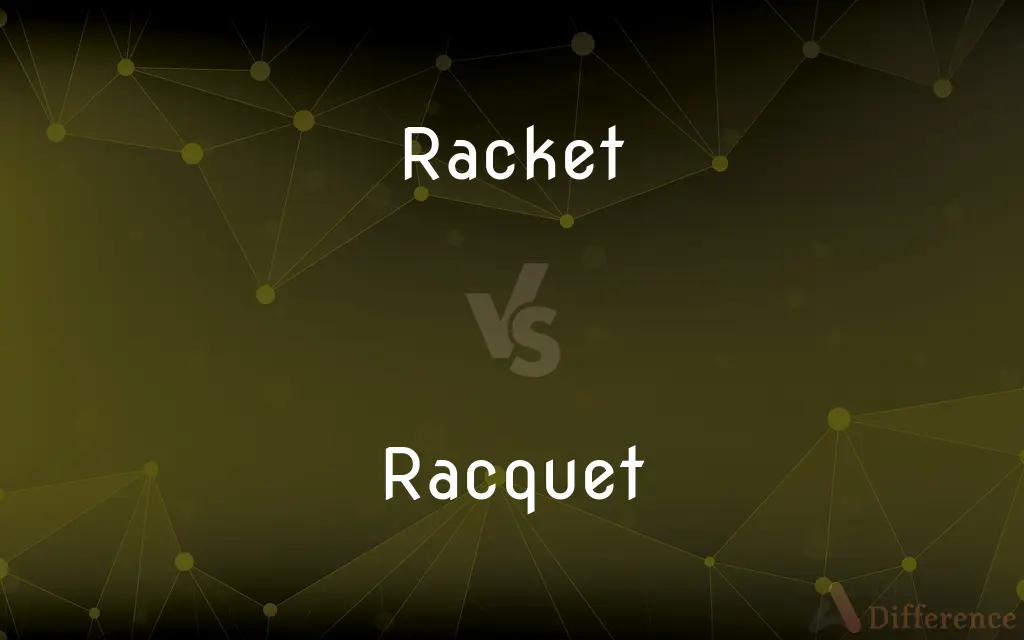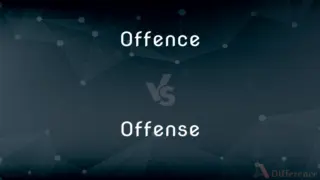Racket vs. Racquet — What's the Difference?
By Tayyaba Rehman & Fiza Rafique — Updated on March 15, 2024
Racket is primarily used in sports like tennis and badminton, focusing on string tension and frame stiffness. Racquet, often seen in "racquetball," emphasizes speed and maneuverability.

Difference Between Racket and Racquet
Table of Contents
ADVERTISEMENT
Key Differences
Racket sports involve equipment designed to strike a ball or shuttlecock across a net or within designated boundaries. These sports typically prioritize elements like string tension, frame stiffness, and overall weight to enhance power and control. Tennis and badminton are classic examples, where the design and material of the racket are crucial for performance, often tailored to the player's style and the game's demands.
Racquet sports, while similar, often refer specifically to games like racquetball, where the equipment's design emphasizes speed, maneuverability, and the ability to handle rapid, close-quarters play. The term "racquet" is sometimes used interchangeably with "racket" but is more commonly associated with certain sports, suggesting subtle differences in equipment specifications and playing styles.
In terms of design, rackets for sports like tennis and badminton often feature larger heads and longer handles to aid in reaching and power generation, suitable for the wide range and high velocity of shots. The construction materials, such as carbon fiber or aluminum, are selected for their balance of strength and flexibility.
On the other hand, racquets used in sports like racquetball are typically smaller and lighter, designed for quick wrist movements and agility. The compact design aids in fast-paced, reflexive exchanges typical of indoor courts, where space is limited and reaction times are crucial.
Players may choose their equipment based on factors like grip size, string pattern, and balance point, which can significantly affect gameplay. In tennis or badminton, a heavier racket with a head-heavy balance might be preferred for baseline power, while a lighter, head-light racquet might be favored in racquetball for control and quick swings.
ADVERTISEMENT
Comparison Chart
Primary Use
Tennis, badminton
Racquetball, squash
Design Focus
String tension, frame stiffness
Speed, maneuverability
Typical Size
Larger head and longer handle
Smaller, more compact design
Material
Carbon fiber, aluminum for flexibility and strength
Lighter materials for quick movements
Playing Style
Power generation, wide shot range
Quick reflexes, close-quarters play
Compare with Definitions
Racket
A device consisting of a handle attached to an oval frame with a network of strings, used in tennis and badminton.
He swung the racket with precision, sending the tennis ball over the net.
Racquet
A bat with a round or oval frame strung with cord, used especially in racquetball and squash.
She gripped her racquet tightly, ready for the serve.
Racket
An implement used for striking the ball in various sports.
Her badminton racket was specially designed for improved aerodynamics.
Racquet
Sports equipment designed for fast-paced, indoor court games.
His new racquet allowed for quicker swings and better control.
Racket
Equipment designed to maximize power and control in game play.
The new model of the racket features an innovative string pattern for better control.
Racquet
An implement used in certain sports to strike a ball, distinct from rackets in its design and usage.
The squash racquet is smaller than a tennis racket for quicker response.
Racket
The term commonly associated with tennis and badminton equipment.
Professional players often have custom-made rackets tailored to their playing style.
Racquet
A tool for playing racquetball, emphasizing speed and agility.
The lightweight racquet improved her maneuverability on the court.
Racket
An object used in sports to hit a ball or shuttlecock.
He replaced his old racket with a more advanced one to improve his game.
Racquet
A device used in specific sports, characterized by its compact design.
The professional player chose a high-quality racquet for the championship match.
Racket
A bat with a round or oval frame strung with catgut, nylon, etc., used especially in tennis, badminton, and squash
A squash racket
Racquet
Variant of racket1.
Racket
A loud unpleasant noise; a din
The kids were making a racket
Racquet
Alternative form of racket
Racket
An illegal or dishonest scheme for obtaining money
A protection racket
Racquet
To hit with a racquet.
Racket
Make or move with a loud unpleasant noise
Trains racketed by
Racquet
To play a game that involves using a racquet.
Racket
Enjoy oneself socially; go in pursuit of pleasure or entertainment
A fabulous car for racketing around Paris
Racquet
To dart about in a manner reminiscent of a ball hit by a racquet.
Racket
A device consisting of an oval or circular frame with a tight interlaced network of strings and a handle, used to strike a ball or shuttlecock in various games.
Racquet
To exchange back and forth, similar to the way a tennis ball volleys back and forth.
Racket
A wooden paddle, as one used in table tennis.
Racquet
See Racket.
Racket
A snowshoe.
Racquet
A sports implement (usually consisting of a handle and an oval frame with a tightly interlaced network of strings) used to strike a ball (or shuttlecock) in various games
Racket
A loud distressing noise.
Racket
A dishonest or fraudulent business or practice.
Racket
Often rackets An illegal moneymaking activity, especially one controlled by organized crime.
Racket
An easy, profitable means of livelihood.
Racket
(Slang) A business or occupation.
Racket
To make or move with a loud distressing noise.
Racket
To lead an active social life.
Racket
An implement with a handle connected to a round frame strung with wire, sinew, or plastic cords, and used to hit a ball, such as in tennis or a birdie in badminton.
Racket
(Canada) A snowshoe formed of cords stretched across a long and narrow frame of light wood.
Racket
A broad wooden shoe or patten for a man or horse, to allow walking on marshy or soft ground.
Racket
A loud noise.
Power tools work quickly, but they sure make a racket.
With all the racket they're making, I can't hear myself think!
What's all this racket?
Racket
An illegal scheme for profit; a fraud or swindle; or both coinstantiated.
Prostitution and gambling controlled by rackets
They had quite a racket devised to relieve customers of their money.
Racket
A carouse; any reckless dissipation.
Racket
Something taking place considered as exciting, trying, unusual, etc. or as an ordeal.
Racket
To strike with, or as if with, a racket.
Racket
(intransitive) To make a clattering noise.
Racket
To be dissipated; to carouse.
Racket
A thin strip of wood, having the ends brought together, forming a somewhat elliptical hoop, across which a network of catgut or cord is stretched. It is furnished with a handle, and is used for catching or striking a ball in tennis and similar games.
Each one [of the Indians] has a bat curved like a crosier, and ending in a racket.
Racket
A variety of the game of tennis played with peculiar long-handled rackets; - chiefly in the plural.
Racket
A snowshoe formed of cords stretched across a long and narrow frame of light wood.
Racket
A broad wooden shoe or patten for a man or horse, to enable him to step on marshy or soft ground.
Racket
Confused, clattering noise; din; noisy talk or sport.
Racket
A carouse; any reckless dissipation.
Racket
A scheme, dodge, trick, or the like; something taking place considered as exciting, trying, unusual, or the like; also, such occurrence considered as an ordeal; as, to work a racket; to stand upon the racket.
Racket
An organized illegal activity, such as illegal gambling, bootlegging, or extortion.
Racket
To strike with, or as with, a racket.
Poor man [is] racketed from one temptation to another.
Racket
To make a confused noise or racket.
Racket
To engage in noisy sport; to frolic.
Racket
To carouse or engage in dissipation.
Racket
A loud and disturbing noise
Racket
An illegal enterprise (such as extortion or fraud or drug peddling or prostitution) carried on for profit
Racket
The auditory experience of sound that lacks musical quality; sound that is a disagreeable auditory experience;
Modern music is just noise to me
Racket
A sports implement (usually consisting of a handle and an oval frame with a tightly interlaced network of strings) used to strike a ball (or shuttlecock) in various games
Racket
Celebrate noisily, often indulging in drinking; engage in uproarious festivities;
The members of the wedding party made merry all night
Let's whoop it up--the boss is gone!
Racket
Make loud and annoying noises
Racket
Hit (a ball) with a racket
Common Curiosities
Can the terms racket and racquet be used interchangeably?
While often used interchangeably, "racket" is more commonly associated with tennis and badminton, and "racquet" with racquetball and squash, reflecting slight differences in equipment and sport.
What makes a tennis racket different from a racquetball racquet?
A tennis racket typically has a larger head and is designed for power and range, whereas a racquetball racquet is smaller and designed for speed and maneuverability.
Are materials for rackets and racquets different?
Both may use similar materials like carbon fiber, but the design and construction vary to suit the specific needs of the sport, such as weight and balance.
Why would a player choose a racquet over a racket for certain sports?
Players choose based on the sport's demands, with racquets typically preferred for their agility and control in fast-paced games like racquetball.
How often should a racket or racquet be restrung?
This depends on usage and level of play, but generally, rackets and racquets should be restrung whenever there's a noticeable decline in tension or performance.
Can beginners use the same rackets and racquets as professionals?
Yes, but beginners might benefit from equipment tailored to learning, with variations in weight and balance to aid in developing skills.
How does the design of a racket affect a player's performance?
The design, including string tension and balance, can significantly impact power, control, and swing speed, affecting overall performance.
Is there a standard size for tennis rackets and racquetball racquets?
Sizes can vary, but tennis rackets generally have larger heads for a broader range of shots, while racquetball racquets are more compact for quick swings.
What role does the frame stiffness of a racket play?
Frame stiffness impacts power and vibration; stiffer frames transfer more force to the ball but can also increase shock to the arm.
Can racket and racquet designs impact injury risk?
Yes, design factors like weight, balance, and stiffness can influence the risk of overuse injuries, emphasizing the importance of proper equipment selection.
What is the significance of grip size in rackets and racquets?
Grip size affects comfort and control; an incorrect size can lead to poor handling and increased risk of injury.
Are there different types of strings for rackets and racquets?
Yes, strings vary in material and tension, affecting playability, power, and control, with choices depending on player preference and style.
Are there specific rules regarding racket and racquet dimensions in official competitions?
Yes, sports governing bodies have specific regulations on equipment dimensions and characteristics to ensure fair competition.
How does the balance point of a racket or racquet affect gameplay?
The balance point can influence swing weight and maneuverability, with head-heavy designs favoring power and head-light designs favoring control.
Share Your Discovery

Previous Comparison
Proved vs. Proven
Next Comparison
Offence vs. OffenseAuthor Spotlight
Written by
Tayyaba RehmanTayyaba Rehman is a distinguished writer, currently serving as a primary contributor to askdifference.com. As a researcher in semantics and etymology, Tayyaba's passion for the complexity of languages and their distinctions has found a perfect home on the platform. Tayyaba delves into the intricacies of language, distinguishing between commonly confused words and phrases, thereby providing clarity for readers worldwide.
Co-written by
Fiza RafiqueFiza Rafique is a skilled content writer at AskDifference.com, where she meticulously refines and enhances written pieces. Drawing from her vast editorial expertise, Fiza ensures clarity, accuracy, and precision in every article. Passionate about language, she continually seeks to elevate the quality of content for readers worldwide.














































